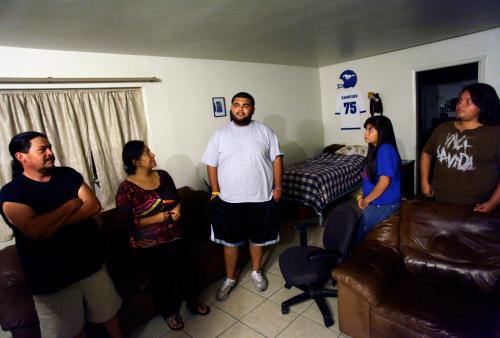As the foreign-born have grown more numerous, they have dispersed geographically. Some metropolitan areas have become immigrant gateways for the first time. And within many metropolitan areas, increasing numbers of immigrants have settled in suburban communities, where they were once only a sparse presence.
Meanwhile, another change has been taking place on the metropolitan landscape: poverty is on the rise in the suburbs. Recent Brookings research shows that at the end of the Great Recession a majority of the nation’s poor in the 100 largest metropolitan areas lived in the suburbs.
An analysis of poverty levels among U.S.-born and foreign-born residents in the nation’s 95 largest metropolitan areas in 2000 and 2009 shows that:
- Foreign-born residents of America’s suburbs experienced markedly higher poverty rates (14.1 percent) than the U.S. born (9.8 percent) in 2009. The 2.7 million foreign-born poor in the suburbs represented one of every five suburban residents living in poverty.
- Immigrants accounted for almost a third (30 percent) of overall population growth in the suburbs from 2000 to 2009, but less than a fifth (17 percent) of the increase in the poor population. The suburbanization of poverty accelerated most among the U.S. born who accounted for 83 percent of the growth in suburban poverty.
- Between 2000 and 2009 immigrants contributed more to the growth of the suburban poor population in the South than in other regions. In Washington, D.C., 40 percent of the growth in the suburban poor was due to immigrants, while they contributed just 11 percent in Detroit. In 2009, immigrants made up the highest share of suburban poor in the West (27 percent) and the lowest in the Midwest (10 percent). In Miami, Los Angeles, McAllen, and Fresno, immigrants made up more than one third of the poor population living in suburbs.
- The West was the only region where the poverty rate of suburban immigrants decreased between 2000 and 2009. Atlanta saw the largest increase in its suburban immigrant poverty rate (6.5 percentage points) while three large immigrant destinations—McAllen, Los Angeles, and Riverside—experienced decreases.
- Among immigrants currently living in suburban areas, those who arrived in the United States prior to 2000 had a lower poverty rate (13%) in 2009 than those who had arrived more recently (22 percent). Sixty-one percent of all foreign-born who arrived prior to 2000 were living in suburban areas by 2009; likewise, a majority (53 percent) of new arrivals who are poor also lived in the suburbs.
- Foreign-born poor in the suburbs are less educated, but more likely to be employed, than their native-born counterparts. The families of the suburban immigrant poor also are more likely to be married couples with children, rather than female-headed households as is most common among the U.S.-born poor.
Demographic change and economic tumult have changed the geography of poverty across and within U.S. metropolitan areas. As a result of these intersecting trends, many suburban areas with little experience with either immigration or poverty face new and distinctive public policy challenges. Suburban governments, nonprofits, and private funders—many with already stretched budgets—will need to modify and extend their programming to reach immigrants living in poverty.


